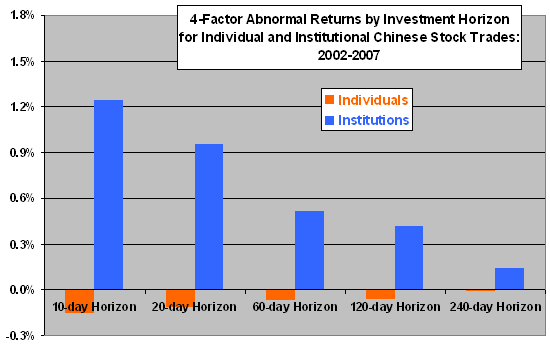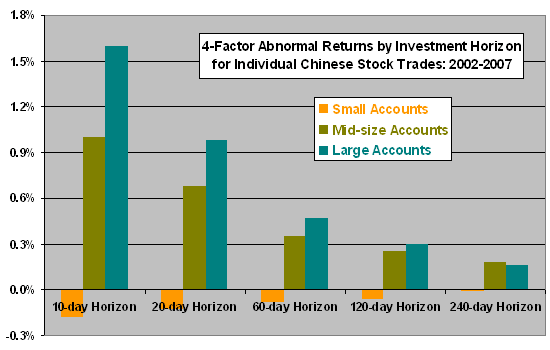Does the experience of individual investors in China confirm that trading tends to transfer wealth from individuals to institutions? Are there groups of individual investors who excel? In their February 2010 draft paper entitled “Do All Individual Investors Lose by Trading?”, Wei Chen, Zhuwei Li and Yongdong Shi examine the trading performance of three categories of individual investors segmented by account size and several categories of institutional investors. Using the complete transaction history and account information of all traders on the Shenzhen Stock Exchange (68.4 million individual and institutional accounts) to construct portfolios that mimic the buys and sells of each investor group over the period 2002-2007, they conclude that:
- Individual investors generate roughly 90% of exchange trade value, with the group having small accounts comprising nearly 99% (97%) of individual traders (individual trade value).
- In aggregate, individuals lose at an average annualized rate of 7.2% over the sample period, equaling 1.36% of China’s GDP and 3% of total personal income. Sources of this loss are gross trading performance (32% of loss), broker transaction fees (34% of loss) and government transaction taxes (34% of loss).
- Institutions capture part of this loss, realizing an average annualized gain of 2.63% after broker costs and government transaction taxes. Each category of institutions exhibits raw profitability.
- Individuals with mid-size and large accounts (representing only 3% of individual trade value) realize an average net annualized gain of 0.57% from trading.
- On a 4-factor (market return, size, book-to-market, and momentum) risk-adjusted basis, individuals in aggregate earn negative abnormal returns, while institutions earn positive abnormal returns. Among individual groups, those those with small (mid-size and large) accounts earn negative (positive) abnormal returns. (See the charts below.)
- Institutions and individuals with mid-size and large accounts tend to buy and sell past losers, while individuals with small accounts tend to buy and sell past winners.
The following charts, constructed from data in the paper, compare 4-factor alphas for different investor groups based on portfolios that are long (short) the daily buys (sells) of each group compounded for holding periods of 10, 20, 60, 120, or 240 trading days. The first chart suggests that individual investors lose to institutions, with individual underperformance concentrated in the month after trades. The second chart suggests that the individuals with small accounts supply alpha to individuals with larger accounts.


In summary, evidence from detailed Chinese stock account data indicates that the trading of unsophisticated individuals tends to transfer their wealth to institutions and more sophisticated individuals (and to brokers and the government).